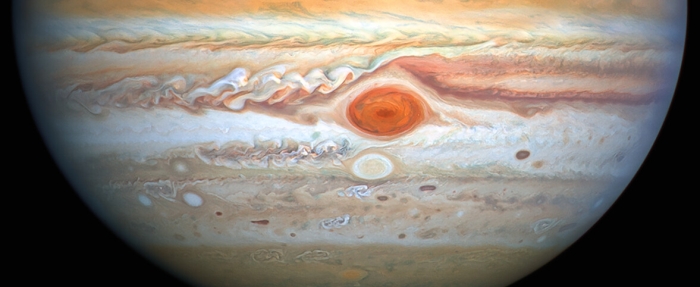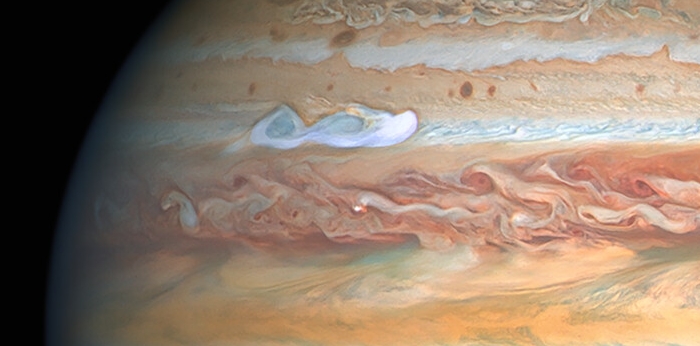Majestic Jupiter, our Solar System's belligerent big brother, is putting its best side forward*. A sharp new image from the Hubble Space Telescope shows the giant planet's wild, ever-evolving weather - revealing both short- and long-term changes.
In the northern hemisphere, turbulent clouds could indicate the formation of a new swirling storm, while down south, a long-lived storm just below and about half the size of the Great Red Spot seems to be slowly changing colour from white to red.
If that's not enough, off to the left we also have a photobomb from ice moon Europa, one of the targets of our search for extraterrestrial life.
The Great Red Spot is the most famous of Jupiter's storms, and it's the most eye-catching feature in this new image. It's a truly enormous storm, rotating anticlockwise, and we think it's been around for at least 350 years.
 (NASA, ESA, A. Simon/Goddard Space Flight Center, M. H. Wong/University of California, Berkeley, and the OPAL team)
(NASA, ESA, A. Simon/Goddard Space Flight Center, M. H. Wong/University of California, Berkeley, and the OPAL team)
In the last few decades, the Great Red Spot appears to have been shrinking, a mystery that has been puzzling scientists, but it's still huge; currently, it measures 15,800 kilometres (9,818 miles) across. That's down from 16,350 kilometres (10,159 miles) in 2017, but still significantly larger than Earth's 12,742-kilometre (7917.5-mile) diameter.
Recently, the Great Red Spot's shrinkage has slowed, but not entirely halted.
Just below it is a storm called Oval BA. It's much younger than the Great Red Spot, but absolutely fascinating in its own right. It formed in the late 1990s from three smaller storms that had been raging for 60 years, and has been intensifying ever since.
Interestingly, it started its newly merged life as a white storm. Then, in 2006, scientists noticed that it was changing colour - turning red like its larger cousin. It didn't stay that way, as you can see. It faded back to white over the course of a few years. But Hubble's new image reveals that the white colouration wasn't permanent either. Oval BA seems to be turning red again.
This will be a fascinating thing to watch in the future, to determine if there's any rhyme or reason behind these colour changes, but it would likely be many years before a pattern can be discerned.
 (NASA, ESA, A. Simon/Goddard Space Flight Center, M. H. Wong/University of California, Berkeley, and the OPAL team)
(NASA, ESA, A. Simon/Goddard Space Flight Center, M. H. Wong/University of California, Berkeley, and the OPAL team)
In the northern hemisphere, at mid-latitudes, a very bright white storm has appeared, travelling at around 560 kilometres per hour (350 miles per hour), trailed by a plume. As you can probably figure out, storms on Jupiter come and go all the time, but this one appears different.
Small, dark cyclonic clumps - rotating anticlockwise - are following behind it, embedded in the plume. We've not seen these before, and scientists think that it might be a nascent long-lived storm, similar to the Great Red Spot and Oval BA in the south.
There's certainly a lot there for planetary scientists to sink their teeth into as they try to understand Jupiter's wild and unpredictable atmosphere. But it's also an awe-inspiring reminder of the beauty and wonder of our little corner of the cosmos.
*Every side is Jupiter's best side.
#Space | https://sciencespies.com/space/glorious-new-hubble-photo-showcases-jupiters-stormy-side/
No comments:
Post a Comment